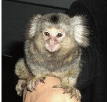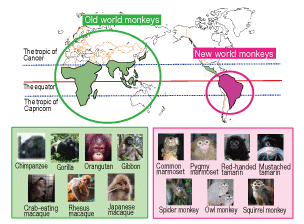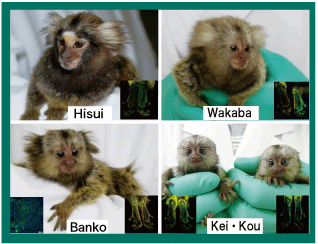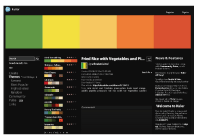BioResource Newsletter Vol.5 No.9
|
|
2009/9/30
| Information on Resource-related Events |
 Announcement of BioResource Symposium Announcement of BioResource Symposium
Date and Time: October 23 (Fri), 2009, 13:00 - 17:45
Place: University Laboratories for Innovation Research Projects,
Matsugasaki Campus, Kyoto Institute of Technology
Details are available at: http://www.nbrp.jp/
|
|
| Research and Bioresources No. 5 |
|
 Use of common marmosets as experimental animals Use of common marmosets as experimental animals
Erika SASAKI
Manager, Department of Marmoset Research,
Central Institute for Experimental Animals
Associate Professor, Center for Human Metabolomic Systems Biology,
School of Medicine, Keio University
|

|
|

|
Common Marmosets
|
|
|
Mice have generally been used as experimental animals, and they have greatly contributed to the advancement of life science research. However, mice are phylogenetically distant and physiologically, anatomically, and histologically different from humans. Therefore, the research results obtained using mice cannot necessarily be replicated in humans. In this perspective, experiments on primates, which are phylogenetically closer to humans in comparison to mice, are considered important for research on human diseases. Common marmosets (Callithrix jacchus; hereafter marmosets) have been used as experimental animals in life science research since the late 1980s, and the number of experimental studies conducted using marmosets has also been increasing over the years.
Marmosets are small primates indigenous to Brazil in South America, and they belong to suborder Anthropoidea, along with humans. Suborder Anthropoidea is further classified into infraorder Catarrhini (old world monkeys) and infraorder Platyrrhini (new world monkeys) (Fig. 1). The new world monkeys diverged from the old world monkeys approximately 2,600-2,700 years ago, and this divergence was presumed to have occurred several hundred years before humans diverged from macaques. As a result of their early divergence, the new world monkeys including marmosets have undergone unique evolutionary changes. While they exhibit some characteristics analogous to humans and other primates, they have also developed a set of unique characteristics which differentiate them from humans and old world monkeys.
One of the most important characteristics of marmosets is their high fecundity. Marmosets attain sexual maturity approximately 1-1.5 years after birth, and their gestation period is approximately 145 days. Marmosets generally deliver 2-3 offsprings at a time, and breeding occurs twice a year. Therefore, a female marmoset may breed 20-30 times during her lifetime, producing as many as 40-80 offsprings. This high fecundity makes the marmoset an ideal experimental animal capable of establishing large colonies within a short span of time. This characteristic also enables us to perform comparative experiments on marmosets having the same sex, age, and weight. In addition, these characteristics are also extremely advantageous for conducting research in embryologic engineering. |
|
Marmosets also differ from humans and old world monkeys in their sensitivity to pathogens. While there have been few reports documenting amphixenosis in marmosets, there have been no reports on the spontaneous attack of the hepatitis B virus. Moreover, the marmosets also exhibit low sensitivity to dysentery, tuberculosis, and salmonellosis. Therefore, the marmosets are considered to be safe primate experimental models because of the extremely low possibility of the experimenters contracting a dangerous amphixenosis.
|

Fig. 1. Global distribution map of primates |

|
Marmoset Research Tools |
|
|
The utility of an experimental animal is obviously attributed to its biological characteristics; however, the availability of analytical tools that can be used to obtain relevant biological information from the animal will greatly expand its usability in research. The number of analytical tools available for conducting research using marmosets has gradually increased in recent years. The whole-genome sequence of marmosets was published by the Genome Sequencing Center, School of Medicine, Washington University in St. Louis in the US, and the sequences are available on their Website. The Children's Hospital Oakland Research Institute has made the bacterial artificial chromosome (BAC) library of the marmoset genome available. Full-length cDNA libraries of the primary organs and brain cDNA microarray chips have also been developed in Japan.
Many surface antigens on the marmoset cells interact with human antibodies. Antibodies against some surface antigens that do not interact with human antibodies have also been developed. Furthermore, marmoset embryonic stem (ES) cells have also been established and are available from RIKEN cell bank.
|

|
Animal Models of Human Diseases
|
|
|
Animal models of human diseases are classified into spontaneous-onset and artificially-developed models. Alzheimer’s disease models, which develop as a result of aging, are an example of spontaneous models. The artificially-developed models are roughly sub-classified into 3 categories depending on the methods used for their development. The first category of artificial models comprises physically-modified models, which are developed by surgical operations. Physically-modified models of spinal cord injury and myocardial infarction have been established in marmosets. The second category comprises drug-administration models, e.g., Parkinson's disease and multiple sclerosis models in marmosets. The third category comprises genetically-modified models. Genetically modified marmoset models of human diseases have not yet been developed; however, the green fluorescent protein (GFP) gene was successfully introduced into the marmosets, recently, (Fig. 2) and the transfer of the introduced gene to the next generation was also confirmed. |
|
Therefore, this method is considered to be a highly promising tool for developing genetically modified marmoset models of human diseases. It is expected that this technology will contribute to the development of treatment methods for diseases such as amyotrophic lateral sclerosis and muscular dystrophy, which has been lacking, until recently, due to the non-availability of effective disease models. In addition, this method can be used for developing marmosets that exhibit tissue-specific expression of fluorescent proteins; this will eventually enable noninvasive observation of the temporal development of neural cells in a single individual for the first time. Consequently, this technology will contribute to the replacement, reduction, and refinement (3Rs) of experiments using animal models.■ |
|

Fig. 2: Genetically modified marmosets
|
|
|
|

|
Erudite Lecture Series by Dr. Benno : No. 9 |

|
|
|
Experiment on the effects of a continuous meat-oriented diet
I have investigated the "bowel age" of many people. Among them, there was a 20-year-old lady whose bowel age was more than 70 years. This lady was on a diet of packaged snacks and soft drinks, and she rarely ate staple foods. She provided a fecal sample in order to determine her bowel age. A laxative had to be used to obtain the sample because she had been experiencing constipation for 2 weeks.
Generally, human feces are weakly acidic in nature; however, the fecal sample from the lady was alkaline in nature. Her diet was found to be more meat-oriented than that of my carnivorous pet dog. These results were astonishing even for an experienced medical practitioner like me, who had never observed such results previously.
This example clearly proves that dietary habit is the most crucial factor that influences bowel age and could make it older than a person's actual age. Food is digested and absorbed in the small intestine and then transferred to the large intestine. Because the food remnants that are difficult to digest are consumed by enteric bacteria, a person’s diet greatly influences the composition of enteric bacteria.
Harmful enteric bacteria favor protein- and fat-rich foods. These ingredients are utilized by the enteric bacteria, and the amines and bile acids necessary for decomposing fats are converted to carcinogens. Fast foods such as hamburgers, which are greatly favored by the youngsters, are also favored by harmful enteric bacteria.
In contrast, foods that are favored by beneficial enteric bacteria are vegetables, seaweeds, and grains rich in dietary fibers. Dietary fibers are extremely important in maintaining bowel health, and their deficiency causes the retention of feces in the bowel for long periods of time, thereby causing a proliferation of harmful bacteria.
|

|
According to an investigation conducted by the Ministry of Agriculture, Forestry, and Fisheries of Japan (MAFF), the average meat consumption was approximately 3 kg in 1960; however, meat consumption has shown more than a 14-fold-increase over the past 35 years. The change in the dietary habit from a traditional diet based on grains, vegetables, and fish to a meat-oriented diet greatly affected the enteric environment of the Japanese population. When I was in my 30s, I volunteered for an experiment that required me to eat 1.5 kg of beef per day for 40 days. The continuation of a meat-oriented diet induced a distinctive change in my body. My body odor became stronger, and my skin became greasy. Importantly, a drastic change in coloration was also observed in my feces. Brownish yellow feces gradually changed its coloration to bistered, brownish, and blackish brown; tar-like feces were defecated on the 40th day. The odor of the feces was extremely strong and, it smelled rotten and rancid. My bowel age was probably higher than 70 years at the time. Although this meat-oriented diet of mine was part of an exaggerated experiment, many people presumably consume unbalanced meals, such as instant foods and snacks, with few vegetables. Let us be conscious about maintaining a well-balanced dietary habit in order to stop bowel aging and to rejuvenate our bowels.
|
| |
|
|
 When puzzled by color scheme When puzzled by color scheme
Many readers of this newsletter often present posters and slides at conferences and seminars. The use of an appropriate coloring scheme is an important aspect in preparing easy-to-understand briefing materials. Multiple colors are frequently used in posters and slides; however, it is quite difficult to determine an appropriate color scheme or the balance of colors that matches the presented content. Sometimes we regret that we spent too much time deciding what colors to use rather than what to present. These are the instances when."Kuler" by Adobe is recommended. Please open the website using the following link.
http://kuler.adobe.com/
|
|
|
This website displays palettes with various colors. The palettes created by people around the world can be seen and searched on the website (※1). For example, when you are wondering what colors are suitable for your briefing materials on research achievements regarding rice, Kuler provides a selection of color palettes upon searching for the term "rice" in the search box on the webpage (※2). The image of "rice" clearly depends on a person's perception, and therefore, you may not necessarily like the colors that appear on the website. Nevertheless, this website may greatly help you by providing examples of color palettes when you are confused about what colors to use in a presentation. Please use the Kuler website when you are puzzled by color scheme. |

Kuler Website
|
|
※1:Once registered, you can create your own palettes and share them with other users.
※2:To aid in indexing and searching, users are required to provide keywords associated with the palettes they prepared.
In addition to the online Kuler, you can also download the Kuler desktop (Fig. 1), an AIR application, from the “Download the Kuler desktop” link on the following website.
http://www.adobe.com/jp/products/kuler/
In the desktop version, you can drag the palettes of your choice to your desktop (Fig. 2).
The color code of each color can be obtained by right-clicking on the palette. In the example on Fig. 3, the value "FF8233" is copied onto the clipboard.
|

(Shingo SAKANIWA and Mutsumi SAITO)
|
|
Editor's Note: We still have fresh memories regarding Dr. Sasaki's achievement, who for the first time succeeded in developing transgenic marmosets. Her research was published in the May 28 issue of Nature, whose cover was adorned by the picture of Hisui. Marmosets will continue to arouse great interest because of their tremendous potential in medical research as experimental animals. Dr. Sasaki's success story is also documented in an interview posted on the Nature Website (http://www.natureasia.com/japan/nature/authors/interview-1.php). I would like to wholeheartedly acknowledge Dr. Sasaki for finding the time to contribute to this newsletter, in spite of her busy schedule. (Y.Y.)
|
Contact Address:
1111 Yata, Mishima-shi, Shizuoka 411-8540, Japan
Center for Genetic Resource Information, National Institute of Genetics
Tel: 055-981-6885 (Yamazaki)
E-mail brnews@chanko.lab.nig.ac.jp
"translated by ASL translation service and proofread by Sharoh Yip"
|
|












